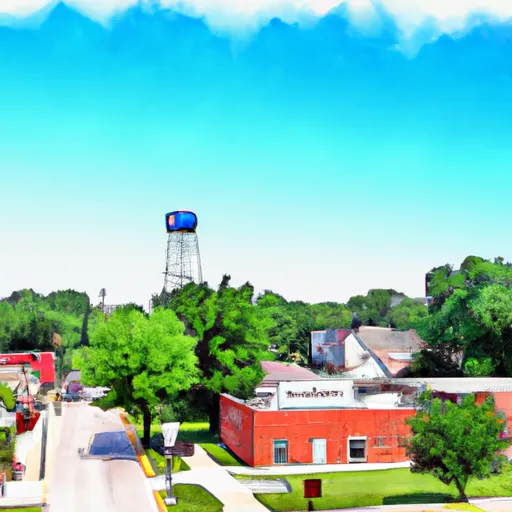-
 Snoflo Premium
Snoflo Premium
Get unlimited access to all our content
With no Ad interruptions! - Start Your Free Trial Login with existing account
Springerton
Eden Index
Climate
8.3
•
Recreation
1.1
•
Community
•
Safeguard
3.7/10

Springerton, Illinois is a small rural town located in White County. The climate in Springerton is classified as humid continental, characterized by hot and humid summers, and cold winters. The average temperature ranges from 25°F (-4°C) in January to 85°F (29°C) in July. Precipitation is evenly distributed throughout the year, with an average annual rainfall of 42 inches (1067 mm).
Hydrologically, Springerton is situated near the Little Wabash River, a major waterway in the region. The river provides recreational opportunities such as fishing and boating. Additionally, Springerton is surrounded by several lakes and ponds, making it an ideal spot for water-based activities like swimming and kayaking.
Outdoor recreation opportunities are abundant in Springerton. The town is surrounded by picturesque landscapes, including forests and rolling hills, making it perfect for hiking and biking enthusiasts. Nature lovers can explore nearby parks and wildlife areas, where they can enjoy birdwatching and wildlife spotting. The area is also known for its hunting and fishing, attracting sportsmen from across the region.
In conclusion, Springerton, Illinois offers a diverse climate, abundant hydrology constituents, and various outdoor recreation opportunities for residents and visitors alike.
What is the Eden Index?
The Snoflo Eden Index serves as a comprehensive rating system for regions, evaluating their desirability through a holistic assessment of climate health, outdoor recreation opportunities, and natural disaster risk, acknowledging the profound impact of these factors on livability and well-being.
Climate Health Indicator (CHI): 8.3
Springerton receives approximately
1137mm of rain per year,
with humidity levels near 82%
and air temperatures averaging around
13°C.
Springerton has a plant hardyness factor of
6, meaning
plants and agriculture in this region thrive during a short period during spring and early summer. Most
plants will die off during the colder winter months.
By considering the ideal temperature range, reliable water supplies, clean air, and stable seasonal rain or snowpacks, the Climate Health Indicator (CHI) underscores the significance of a healthy climate as the foundation for quality living.
A healthy climate is paramount for ensuring a high quality of life and livability in a region, fostering both physical well-being and environmental harmony. This can be characterized by ideal temperatures, reliable access to water supplies, clean air, and consistent seasonal rain or snowpacks.
Weather Forecast
Streamflow Conditions
Wabash
Area Rivers
Wabash
Snowpack Depths
Wabash
Reservoir Storage Capacity
Wabash
Groundwater Levels
Recreational Opportunity Index (ROI): 1.1
The Recreational Opportunity Index (ROI) recognizes the value of outdoor recreational options, such as parks, hiking trails, camping sites, and fishing spots, while acknowledging that climate plays a pivotal role in ensuring the comfort and consistency of these experiences.
Access to outdoor recreational opportunities, encompassing activities such as parks, hiking, camping, and fishing, is crucial for overall well-being, and the climate plays a pivotal role in enabling and enhancing these experiences, ensuring that individuals can engage in nature-based activities comfortably and consistently.
Camping Areas
| Campground | Campsites | Reservations | Toilets | Showers | Elevation |
|---|---|---|---|---|---|
| Charley Brown City Park | None | 487 ft | |||
| Citronelle Lakeview RV Park | 24 | 226 ft | |||
| Gibson City Park | 4 | 731 ft | |||
| Lake Tom Bailey | 32 | 299 ft | |||
| Lenoir Landing - Coffeeville Lake | None | 52 ft | |||
| Natchez Trace State Park | 50 | 637 ft | |||
| Lakeview RV City Park | None | 230 ft | |||
| Bladon Springs State Park | 10 | 193 ft | |||
| Sumter Rec Area | None | 128 ft | |||
| Cochrane | None | 166 ft |
Nearby Ski Areas
Catastrophe Safeguard Index (CSI):
The Catastrophe Safeguard Index (CSI) recognizes that natural disaster risk, encompassing floods, fires, hurricanes, and tornadoes, can drastically affect safety and the overall appeal of an area.
The level of natural disaster risk in a region significantly affects safety and the overall livability, with climate change amplifying these risks by potentially increasing the frequency and intensity of events like floods, fires, hurricanes, and tornadoes, thereby posing substantial challenges to community resilience and well-being.
Community Resilience Indicator (CRI):
The Community Resilience Indicator (CRI) recognizes that education, healthcare, and socioeconomics are crucial to the well-being of a region. The CRI acknowledges the profound impact of these elements on residents' overall quality of life. By evaluating educational resources, healthcare accessibility, and economic inclusivity, the index captures the essential aspects that contribute to a thriving community, fostering resident satisfaction, equity, and social cohesion.

